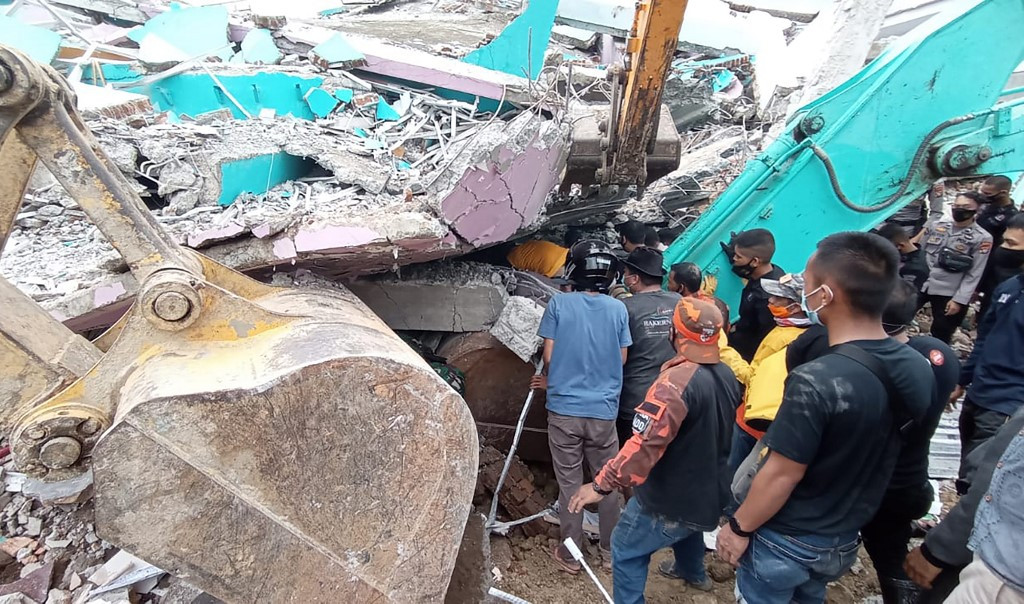Popular Reads
Top Results
Can't find what you're looking for?
View all search resultsPopular Reads
Top Results
Can't find what you're looking for?
View all search resultsVirus fears haunt disaster relief efforts
Public compliance with the existing COVID-19 protocols is said to remain an integral part of evacuation and mitigation efforts following a string of fatal disasters that struck several regions across the archipelago over the last two weeks.
Change text size
Gift Premium Articles
to Anyone
T
he National Disaster Mitigation Agency (BNPB) is pushing for COVID-19 safety compliance during disaster response and among people taking shelter following a string of fatal disasters that struck several regions across the archipelago over the last two weeks.
Agency spokesperson Raditya said health protocols would continue to be enforced amid the ongoing emergency in the wake of earthquakes in West Sulawesi, major flooding in South Kalimantan and deadly landslides in West Java.
“All health protocols must be implemented,” he told an online press conference on Sunday.
Raditya went on to say that a joint team comprising his office, the Health Ministry and local health agencies had committed to providing the provisions and amenities required to maintain health and safety among evacuees.
Evacuees, divided into separate age groups to prevent viral contagion, had been ordered to keep wearing masks in shelters, he said. Swab antigen tests would also soon be provided to all evacuees to ensure proper handling of potential COVID-19 patients, he added.
“Shelters will be concentrated in two locations [in each disaster-hit region],” Raditya said. “Access to the shelters will be limited.”
The country has been tackling the aftermaths of at least three major natural disasters in recent weeks.
Read also: Medics in West Sulawesi overwhelmed by quake casualties
At least 56 people died, 826 others were injured and 15,000 displaced following the 6.2- and 5.9-magnitude quakes that hit West Sulawesi on Thursday and Friday, according to the BNPB.
Reports of residents fleeing their homes without protective health gear during the tremors previously raised concerns over violations of health protocols imposed to curb coronavirus transmission in the region.
Mamuju resident Agung Massagoni claimed on Friday that the evacuation was far from ideal as dozens of the evacuees had yet to receive assistance from the government, leaving them with no choice but to provide for themselves.
He told The Jakarta Post that the lack of masks and tents had made it difficult for evacuees to remain compliant with the prevailing health protocols.
The BNPB’s Raditya said the government was currently distributing aid packages to Majene and Mamuju, which included at least eight isolation tents, 10 evacuation tents, 500,000 cloth masks, over 2,000 packages of food supplies, 700 blankets and 30 electric generators.
In South Kalimantan, local authorities declared a state of emergency on Thursday as flooding in at least seven regencies forced more than 112,000 people to flee their homes.
Read also: Rescuers among casualties of West Java landslides
On Jan. 9, a series of landslides in Sumedang, West Java wreaked havoc and devastated dozens of families, with at least 29 dead and 11 still missing.
Heavy rainfall began in the afternoon, and the first landslide occurred at around 4 p.m. when a 20-meter cliff in Cihanjuang village in Sumedang’s Cimanggung district collapsed and buried 14 houses beneath it. At 6:30 p.m., as a search and rescue team sought to rescue victims from the houses, another landslide occurred, killing several members of the team.
According to the BNPB, the government has provided 1,000 reusable masks, 48 tents and 200 blankets to the evacuees, among other provisions.
As of Monday, the BNPB’s disaster geoportal had recorded 154 disasters nationwide this year, with 586,828 people displaced, 776 injured, 140 killed and 13 missing
University of Indonesia epidemiologist Pandu Riono said the current evacuation efforts served as a model of disaster mitigation during a public health crisis.
Read also: A perfect storm: Indonesia braces for more disasters amid COVID-19, plane investigation
Protective health equipment such as masks should now be viewed as an essential part of aid packages, considering that the ongoing pandemic has not shown any signs of abating anytime soon, according to him.
“Most importantly, the masks should be reusable,” Pandu told the Post. “Disposable masks could prove counterproductive in evacuation areas as the lack of any emergency disposal sites may only lead to increased risk of coronavirus transmission among evacuees.”
He further said it was critical that local disaster mitigation teams establish separate shelters for evacuees who also happen to be critical COVID-19 patients.
Indonesia’s cumulative tally of coronavirus cases hit 917,015 on Monday, 11 months since the first cases were reported in March last year. The number of daily COVID-19 cases soared from above 7,000 in late December last year to above 11,000 in the past week, with occasional declines some days.










